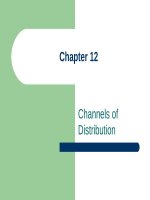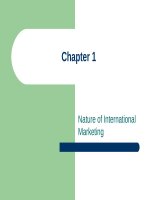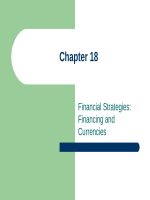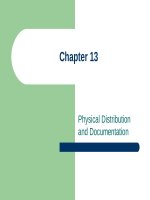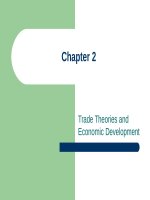Lecture International marketing: Strategy and theory - Chapter 17: Pricing strategies: Countertrade and terms of sales/payment
Bạn đang xem bản rút gọn của tài liệu. Xem và tải ngay bản đầy đủ của tài liệu tại đây (144.17 KB, 15 trang )
Chapter 17
Pricing Strategies:
Countertrade and Terms
of Sales/Payment
Chapter Outline
Countertrade
- Types of Countertrade
- Problems and Opportunities
Price Quotation
Terms of Sale
- Trade Terms
- Quotation Guidelines
Chapter Outline
Methods
-
of Financing and Means of payment
Consignment
Open Account
Cash in Advance
Bill of Exchange (Draft)
Bankers' Acceptance
Letter of Credit
Countertrade
goods
for goods trade (vs. monetary trade)
government mandate to pay for goods and
services with something else other than cash
Countertrade
Advantages
serving as trade financing
buyer getting rid of surplus of own products
no concern for fluctuation of exchange rates
Countertrade
Disadvantages
cumbersome and time-consuming
costly
inferior form of exchange
- requiring "double coincidence of wants"
Types of Countertrade
Barter
- single transaction of direct exchange of products of
equal value
Counterpurchase (Parallel Barter)
- two transactions of cash sales agreements (of
unrelated products)
Compensation Trade (Buyback)
- products sold and later bought by a party are related
Types of Countertrade
Offset
- for the rights to sell its product in a foreign market,
the seller must manufacture the product locally (in
the host country)
Clearing Agreement
- line or credit established in central banks of two
countries
- use "clearing account units" for exchange of
products
Trade Terms
-
EXW (Ex Works)
price of product only; nothing else being included
FAS (Free Alongside Ship)
EXW + local transportation in seller's country
FOB (Free on Board)
FAS + loading onto the vessel
CFR (Cost & Freight)
FOB + international transportation
Trade Terms
CIF
(Cost, Insurance, and Freight)
- CFR + insurance
DEQ (Delivered Ex Quay)
- CIF + unloading
DDP (Delivered Duty Paid)
- DEQ + local transportation in buyer's country
Methods of Financing &
Means of Payment
Consignment
Open
Account
Cash in Advance
Bill of Exchange (Draft)
- Sight Draft
- Time Draft
Methods of Financing &
Means of Payment
Bankers'
Acceptance
Letter of Credit (L/C)
- Revocable vs. Irrevocable
- Unconfirmed vs. Confirmed
- Standby
- Back-to-Back
- Transferable
Export Payment Terms and Risk Level
Open
account (highest risk for exporter)
Sight draft
Time draft
Irrevocable L/C
Confirmed irrevocable L/C
Cash in advance (least risk)
Export Payment Terms and Cost
Open
account (least cost for importer)
Sight draft
Time draft
Irrevocable L/C
Confirmed irrevocable L/C
Cash in advance (highest cost)
L/C: Advantages/Disadvantages
Advantages
–
–
Security (for both parties)
Seller receiving early payment by discounting L/C
Disadvantages
–
–
Lacking flexibility
Complex and potentially costly



